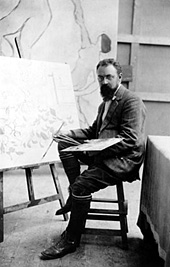“I must break away from tradition, break away from beauty, from sentimentality. This is my drama.”
– Pablo Picasso
“The personality of the artist asserts itself through the struggles it has to go through when pitted against other personalities. If the fight is fatal, it is a matter of destiny.”
– Henri Matisse
KERA: It’s been said that Matisse and Picasso were “modern” artists, artists who worked in the modernist tradition as opposed to the classical or nineteenth century academic tradition.
Perhaps we should start by asking, “What does ‘modernism’ mean?”

Henri Matisse, 1909 (The Pierre Matisse Gallery Archives, The Pierpont Morgan Library, New York, MA 5020/Art Resource)
It’s a life-long process of struggle, of self-definition both between you and your canvases, or you and your plates, or you and your pieces of paper, but also between you and other strong people who you respect.
Yve-Alain Bois: Of course, every artist responds to other artists and also to their particular situation. No artist works in a vacuum. Both Picasso and Matisse inherited from the masters of Post-Impressionism—Cezanne, Van Gogh, Gaugin, Seurat– a legacy characterized by a strong emphasis on the constructive nature of everything: color, brush stroke and so forth.
Picasso was an extraordinary draftsman, basically imitating all kinds of traditional painting by the age of 14. He had an incredible facility, and it took him a while to realize that he had a kind of historical mission, so to speak. And that happened, I think, around 1906, around the time he got acquainted with the work of Matisse.
That very quickly developed into what would become a big splash in the history of art, Les Demoiselles d’Avignon. You don’t have to reproduce the object, you can totally reconstruct it. You don’t have to be homogenous in terms of style—you can use different stylistic features within a painting in a strange, discontinuous way.
It’s the recognition that painting is a language based on arbitrary elements that you can combine at will to create whatever you want. That’s what I think is Modernist for Picasso: the notion that painting is a language.

Pablo Picasso, 1916 (© Photo RMN)
KERA: How did Picasso and Matisse view themselves in relationship to the tradition they had inherited?
Rick Brettell: When Matisse decided to become an artist, you had to learn to be an artist in terms of a tradition that was hundreds of years old for the making of portable easel pictures, and thousands of years old for the making of beautiful objects. And the artist was taught to learn that whole tradition before being able to make an important contribution to it.
Matisse went through an extremely layered and complicated system of instruction which Picasso did only a little bit. Matisse saw himself as an heir to the great tradition of French painting. Picasso would have laughed at being included in that kind of tradition. It’s one of the differences between the two of them. Matisse actually had to break free from that, much more fully than Picasso did.
Yve-Alain Bois: Both Matisse and Picasso thought that academic art was basically dead. But they wanted to rescue the great tradition. They saw it as their duty…they felt that on their shoulders rested the future of a tradition. That’s the way they saw it.
They wanted to rejuvenate it by transforming it. And they knew that was their task. They saw it unconsciously. They never completely formulated it like that, but I deeply believe that was the way they envisioned their own role in the history of art. If they were not going to rescue the tradition, that tradition was going to die. they were not going to the tradition, the tradition was going to die.
I mean, you had mass media, photography, the cinema, Marcel Duchamp’s attack with his ready-mades. Why would painting still be necessary in the age of the magazine? The smell of turpentine was suffering quite a series of hard blows, and they knew that they had to defend painting by transforming it.

